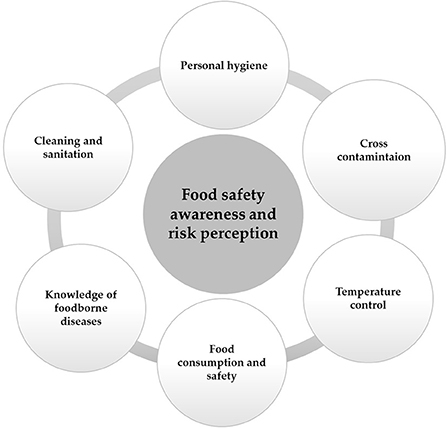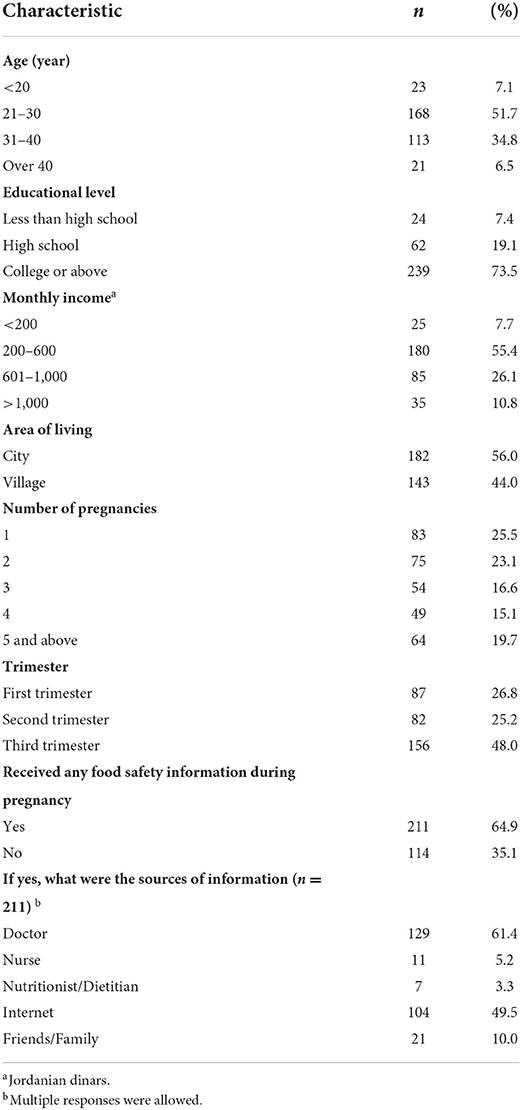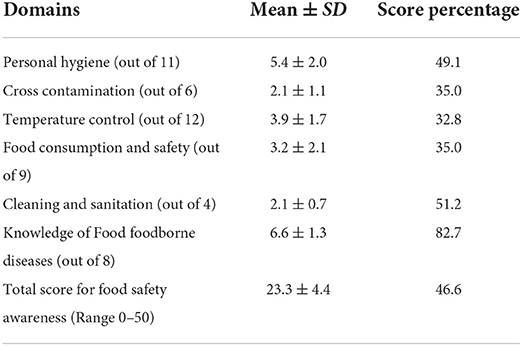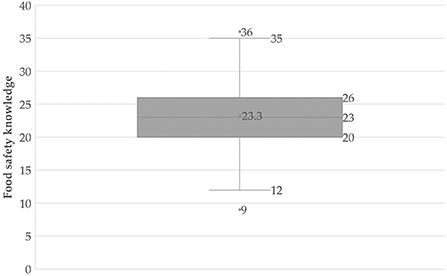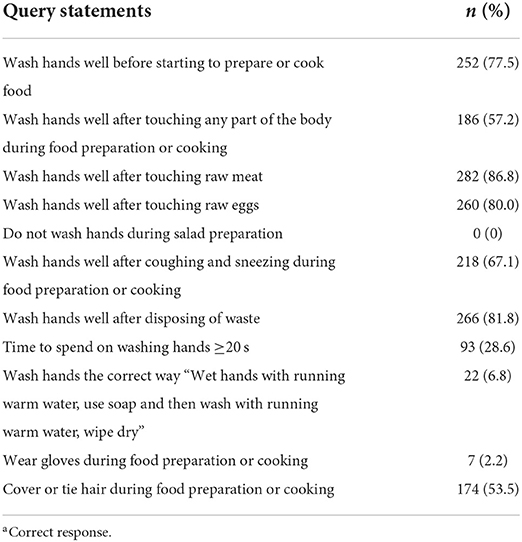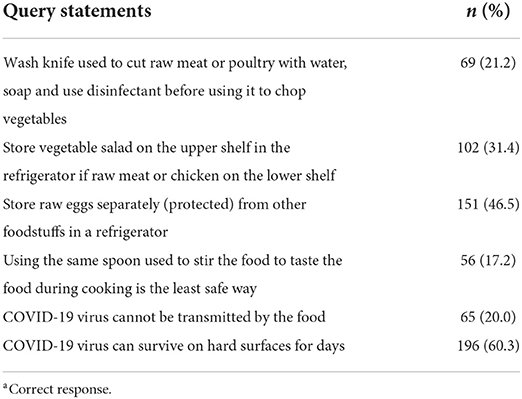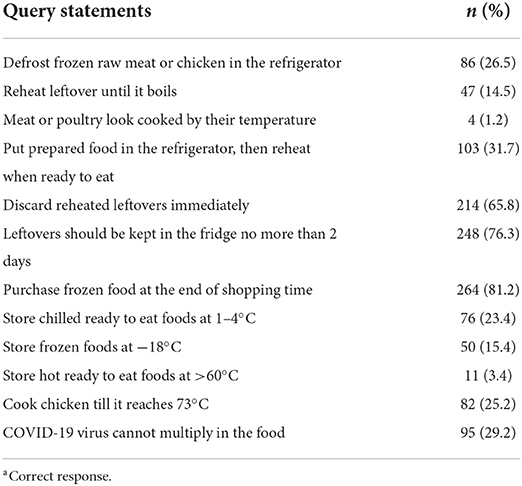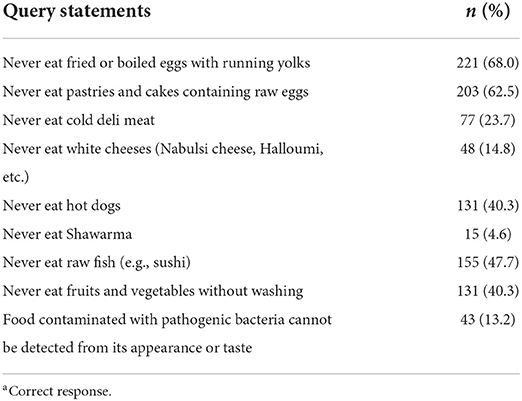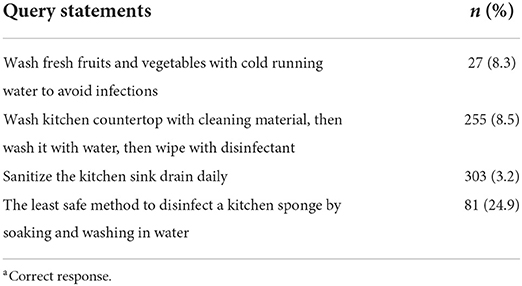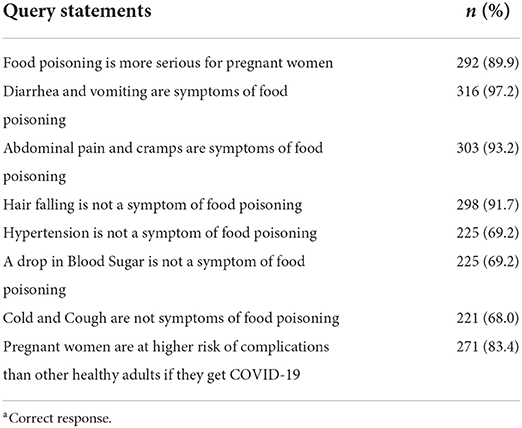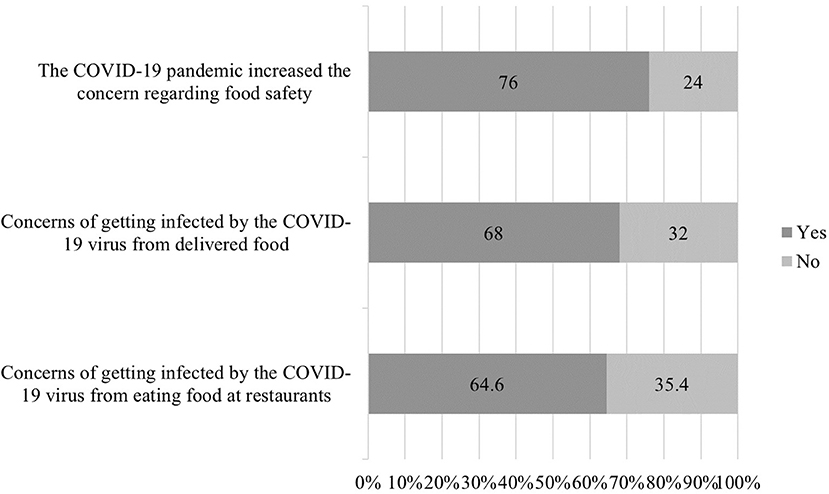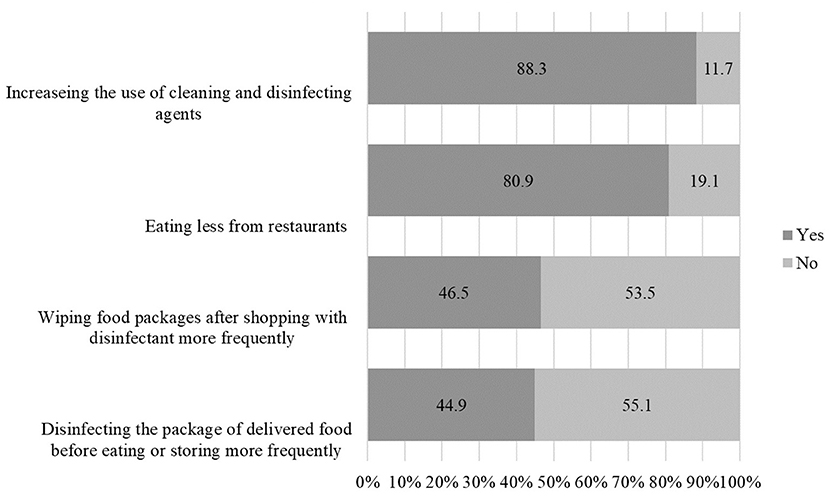- 1Department of Epidemiology, School of Public Health, The University of Alabama, Birmingham, AL, United States
- 2Department of Clinical Nutrition and Dietetics, College of Health Sciences, University of Sharjah, Sharjah, United Arab Emirates
- 3Department of Nutrition and Food Technology, Faculty of Agriculture, Jordan University of Science and Technology, Irbid, Jordan
- 4Department of Obstetrics and Gynecology, Faculty of Medicine, Jordan University of Science and Technology, Irbid, Jordan
- 5Department of Pharmacology, Faculty of Medicine, Jordan University of Science and Technology, Irbid, Jordan
- 6Department of Nutrition and Health, College of Medicine and Health Sciences, United Arab Emirates University, Al Ain, United Arab Emirates
- 7Nuffield Department of Women's & Reproductive Health, University of Oxford, Oxford, United Kingdom
Background: Pregnant women are at a higher risk of food poisoning compared to the general population. This can be detrimental to both the mother and the fetus. This study aimed to assess the level of knowledge and risk perception of basic food safety and handling among pregnant women in Jordan amid the COVID-19 pandemic.
Methods: A descriptive cross-sectional quantitative study among pregnant women in Jordan was conducted using an online questionnaire between November 2020 and January 2021. The survey included socio-demographic data, food safety knowledge, and risk perception questions as well as COVID-19 related questions. A total score for food safety awareness out of 50 was derived for each participant based on the sum of scores from all domains. Student t-test and Analysis of Variance (ANOVA) were conducted using SPSS (Version 26) to compare the mean sum of correct responses of every section (knowledge score) by sociodemographic characteristics.
Results: A total of 325 participants completed the web-based survey. Most of the participants reported receiving food safety-related information during pregnancy (64.9%). The mean total score for the participants was 23.3 ± 4.6 out of 50 (score percentage 46.6%). Participants were mostly aware of foodborne diseases (82.7%) followed by cleaning and sanitation (51.2%), and personal hygiene (49.1%). The least amount of awareness was observed in the cross-contamination (35.0%), food consumption and safety (35.0%), and temperature control (32.8%) domains. Older participants and those with higher education had significantly higher mean scores (p < 0.001). Most participants agreed that the pandemic had a positive impact on enhancing the measures taken to maintain food safety during the pandemic.
Conclusions: This study identified gaps in food safety-related knowledge. Educational programs for pregnant women need robust reinforcement within the community. Efficient educational approaches related to food safety should be provided by health care providers and local health authorities. While the COVID-19 pandemic persists, pregnant women must be well-educated about the virus and its prevention strategies to avoid being infected and ensure their baby's safety as well as their own.
Introduction
Since the preliminary stages of the COVID-19 pandemic and 2 years after its emergence, the COVID-19 disease continues to ravage global health and the economy. Vulnerable and high-risk groups affected by the SARS-CoV-2 virus tend to show more severe symptoms compared to the rest of the population. These include people who are over 60 years old, who have health conditions such as diabetes or heart disease, and who suffer from conditions that diminish normal immune system function (WHO, 2020c). Pregnancy encompasses a wide range of physiological and immunological alterations that could increase the susceptibility to respiratory diseases (Ramsey and Ramin, 2001). It is well-established that pregnant women may develop more severe complications when being infected with COVID-19 as opposed to non-pregnant women (WHO, 2020b). Moreover, adverse pregnancy and neonatal consequences were found to be more common among infected pregnant women including preeclampsia, preterm birth, cesarean deliveries, and stillbirth (Yang et al., 2020), while mother-to-fetus vertical transmission of SARS-CoV-2 remains controversial to date (Kotlyar et al., 2021).
The concept of food safety revolves around handling, preparing, and storing food in a manner that reduces biological risk (in the form of bacteria or viruses) and chemical risk (heavy metal/pesticide contamination, etc). Foodborne diseases pose a significant threat to public health. Numerous findings have indicated that many foodborne outbreaks are related to serious food safety knowledge gaps and improper practices during meal preparation, especially in home settings (Langiano et al., 2012; Wu et al., 2018). According to the World Health Organization (WHO), almost 1 in 10 people worldwide experience food poisoning (WHO, 2020e). Evidence shows that the improper handling of food and deviation from good practices and the Hazard Analysis Critical Control Point (HACCP) system pose a great risk for consumers (Jevšnik et al., 2008). Consumers' improper practices toward food such as consuming raw or undercooked food and poor hygiene, and other practices originating in the domestic environment may contribute to foodborne diseases (Redmond and Griffith, 2003; Haysom and Sharp, 2005). In the light of the COVID-19 pandemic, several reports highlighted the impact of the pandemic on dietary habits, physical activity, mental health as well as hygiene practices, food safety knowledge, and food purchasing and handling behaviors (Cheikh Ismail et al., 2021; Chenarides et al., 2021).
The main cause of the COVID-19 outbreak was linked by many researchers and scientists to local seafood markets in China (Wu et al., 2020). Moreover, direct transmission through person-to-person contact is identified as the main route of transmission of the virus and there is no evidence up to date confirming direct transmission through food or food packages. However, contaminated food, food packages, and surfaces may be considered carriers of the virus (Duda-Chodak et al., 2020; Han et al., 2021). As per general safety guidelines and the increasing number of confirmed COVID-19 cases globally, food safety and handling has become a priority to the public and has been discussed extensively on media platforms, by governments and health authorities (FAO, 2020; FDA, 2021). A recent study among Chinese consumers indicated a significant positive impact of the COVID-19 pandemic on their food safety knowledge and practice (Min et al., 2020) suggesting that public health issues such as the COVID-19 pandemic could encourage people to enhance their food safety awareness and related behavior.
Literature indicates differences in perceived responsibility based on gender, age, and personal relevance (Redmond and Griffith, 2004). It is well-known that pregnant women become more motivated to enrich their health-related knowledge pertaining to the increased level of concern they have for their health and that of their fetuses (Athearn et al., 2004). Several studies showed that pregnant women are not fully aware of the adverse effects of high-risk food consumption during pregnancy and that improper food handling at home could lead to the development of foodborne illnesses (Athearn et al., 2004; Trepka et al., 2006; Xu et al., 2017). Moreover, pregnant women may exhibit some food safety and handling malpractices such as temperature abuse, cross-contamination, and improper handwashing (Athearn et al., 2004; Trepka et al., 2006; Taylor et al., 2012; Xu et al., 2017; Cater et al., 2020). Some researchers have demonstrated that sufficient education about the risk of foodborne pathogens, proper food safety practices, and handling of high-risk foods is not emphasized for pregnant women (Taylor et al., 2012; Pereboom et al., 2013; Xu et al., 2017; Cater et al., 2020). More alarmingly, a study among this group observed that more than 70% of pregnant women consumed high-risk foods during their pregnancy (Xu et al., 2017). Thus, assessing knowledge and practices related to food safety among pregnant women is essential before implementing educational interventions.
There is no doubt that pregnant women are at a higher risk of food poisoning compared to the general population which can pose detrimental impacts on both the mother and the fetus (Tam et al., 2010). To the best of our knowledge, there are no food safety-related studies available on this group in Jordan. Therefore, this study aims to assess the level of knowledge and risk perception of basic food safety and handling among pregnant women in Jordan amidst the COVID-19 pandemic.
Materials and methods
Study design and participants
The current study was conducted in a descriptive cross-sectional quantitative manner. It was implemented between November 2020 and January 2021. The target population included pregnant women who were 18 years and older and living in Jordan. The study population was drawn from obstetrics and gynecology/OB-GYN outpatient clinics at King Abdullah University Hospital in Irbid city. A trained researcher explained the study objectives to participants and obtained verbal consent before the commencement of data collection. A web link directing to the online survey was then shared with pregnant women who agreed to participate via WhatsApp™. Participants were free to exit the survey at any point and data was collected anonymously. No incentives were provided for participation. An information sheet explaining the study protocol and objective was present on the first page. An electronic informed consent was obtained from all participants. The study protocol was approved by the institutional review board (IRB) of Jordan University of Science and Technology (JUST) [Number: 100/136/2020].
The minimum sample size was calculated to be 273 using the formula
With a 95% confidence level and 5% margin of error. The population proportion was set based on population knowledge from previous research among females in Jordan (Osaili et al., 2011). All women who had appointments at the clinic during the study period were invited to participate in the study by the nurse. Out of 350 women invited to take part, a total of 325 pregnant women completed the survey and were included in this study (response rate 93%).
Survey questionnaire
The questionnaire was designed to investigate the level of knowledge and risk perception of food safety and handling among pregnant women during the COVID-19 pandemic. According to the literature on food safety (Trepka et al., 2007; Jevšnik et al., 2008; Saeed et al., 2021) and the five keys to safer food manual by the WHO (2020d) a preliminary draft of the questions was developed by researchers at JUST. The survey draft contained 70 questions on food safety knowledge and risk perception and 15 questions related to food safety during the COVID-19 pandemic. The questions were then reviewed by a panel of experts to assess content validity. The expert group consisted of three professors in food safety and two research associates who provided their consent to take part in the evaluation. The panel was introduced to the aims of the study and the procedures for the assessment before the evaluation. During the evaluation, the questions were checked for overlapping items, clarity, understanding, rationale, and consistency with the Jordanian culture. According to the panel's recommendation, the questions were reduced to 50 for food safety knowledge and risk perception and 8 questions related to food safety during the COVID-19 pandemic. Moreover, the questions that were evaluated as not clear or hard to understand by the panel were modified.
The questions were then translated from English to Arabic by two bilingual researchers and back-translated to English by a third researcher to ensure the equivalency of the two versions. The survey was developed as an open online link via Google Forms, and it was pilot tested with 30 subjects in Jordan. The pilot-testing data were not included in the results of this research and no changes were recommended.
The online survey included 65 items divided into three main sections; socio-demographic information (7 items); food safety knowledge and risk perception questions (50 items) and COVID-19 related questions (8 items). The first section inquired about age, education level, household income level, living in a city or village, number of pregnancies, pregnancy trimester, and if they received any food safety information during pregnancy. The second section of the questionnaire included six domains based on the safer food manual by the WHO (2020d) as shown in Figure 1; personal hygiene (11 items); cross-contamination (6 items); temperature control (12 items); food consumption and safety (9 items); cleaning and sanitation (4 items); and knowledge of foodborne diseases (8 items).
All the questions were close-ended and designed as multiple choices questions and Likert scale with option responses as strongly disagree, disagree, neutral, agree, and strongly agree. A food safety awareness score was derived for each participant by summing the score in each domain of the survey. The score ranged between 0 and 50, the higher the score the greater the food safety awareness.
Statistical analysis
The online survey responses were exported from Google Forms into an Excel file. The data was then cleaned, coded, and imported into Statistical Package for Social Sciences (SPSS) version 26.0 (IBM, Chicago, IL, USA). Descriptive statistics for the sociodemographic characteristics were reported as counts and percentages. Scores for each test category (i.e., personal hygiene, cleaning and sanitation, cross-contamination, temperature control, food consumption and safety, knowledge of foodborne diseases) were calculated as per the correct responses. A total score for food safety awareness out of 50 was derived for each participant based on the sum of scores from all domains. Mean responses and percentages of responses in each category were computed. Student t-test and Analysis of Variance (ANOVA) was conducted to compare the mean sum of correct responses of every section (knowledge score) by age, educational level, family income, area of living, number of pregnancies, current trimester, and receiving food safety information. Binary logistic regression analysis was used to assess the correlation between changed food safety-related behaviors during the COVID-19 pandemic and specific food safety domain scores. Results were significant for p < 0.05.
Results and discussion
Participants profile
A total of 325 participants completed the web-based survey. The general characteristics of the study population are presented in Table 1. The majority of participants were between the ages of 21 and 40 years (86.5%). This was followed by 34.8% from ages 31–40 years. The majority had completed a university degree (73.5%). The highest education level of about 19% of the respondents was a high school. Only 7.4% of the respondents were educated at less than a high school level. Around half of the participants reported having an average monthly household income of 400 Jordanian Dinars (565$) (55.4%) followed by 26.1% of the respondents having an income ranging from 600 to 1,000 Jordanian Dinars. The majority reported living in the city (56.0%). Around one in four participants were experiencing their first pregnancy and almost half of them were in their third trimester (48.0%). The majority of the participants reported receiving food safety-related information during pregnancy (64.9%). Out of those who received food safety awareness, 61.4% were educated by a doctor and 49.5% obtained information from the internet. This was followed by family and friends (10.0%).
Food safety and risk perception
The mean total score for the participants was 23.3 ± 4.6 out of 50 (score percentage 46.6%) (Table 2). A box and whisker plot that portrays the range of food safety scores among participants is shown in Figure 2. The majority of participants were aware of foodborne diseases (score percentage 82.7%) followed by cleaning and sanitation (score percentage 51.2%), and personal hygiene (score percentage 49.1%). Participants were not very well aware of cross-contamination, food consumption and safety, and temperature control (score percentage 35.0, 35.0, and 32.8% respectively). Although more than two-thirds of the participants reported receiving food safety-related information during their pregnancy, food safety awareness was relatively insufficient among participants, as evidenced by answering less than half of the questions correctly. The high knowledge of foodborne diseases could be due to awareness that occurred as a result of experiencing some foodborne disease at some period in the respondent's lifetime. A previous study conducted in Jordanian university female students indicated low level of knowledge related to food safety (Osaili et al., 2011). The high scores in the cleaning and sanitation aspect and the personal hygiene domain could be due to a general practice/self-awareness rather than a strong scientific knowledge base. The information assessed in “cross-contamination,” “temperature control,” and “food consumption and safety” domains are generally not well-known. In other words, good knowledge of these domains usually requires some awareness/education/self-interest. Providing information or educating pregnant women would increase their awareness and underscore the importance of food safety. This would probably translate to better practice. Care must be taken not to limit awareness interventions to pregnant women only, but rather to include household members to prevent any food safety-related mishaps from occurring.
Most of the studies that investigated food safety knowledge among pregnant women discussed knowledge and practices in different aspects but did not provide an overall score. However, these studies concluded, similar to our study, that food safety awareness in several aspects was insufficient among pregnant women. A study among pregnant women in the USA indicated that participants had high confidence regarding safe food consumption and safe food handling skills while poor skills in using the thermometer (Cater et al., 2020). The total food safety awareness score in the present study was higher than that of college students in Jordan (41.3%) (Osaili et al., 2011) and lower than that of women in Sharjah, United Arab Emirates (UAE) (57.4%) (Saeed et al., 2021), women in Dubai, UAE (53.3%) (Osaili et al., 2022), women at Alexandria university (67.4%) (Fawzi and Shama, 2009), and women in Lebanon (74.8%) (Haddad et al., 2020).
Personal hygiene
Practicing personal hygiene before and during food preparation is the chief factor for pathogen control and reduction of foodborne disease incidence (Medeiros et al., 2001). Moreover, in light of the COVID-19 pandemic, frequent handwashing is highly recommended to minimize the risk of COVID-19 infection and outbreaks (Haque, 2020). Table 3 shows the query statements and participants' correct responses to personal hygiene questions. Many participants in the present study were aware of the proper practices concerning handwashing after handling raw meat, raw eggs, and disposing of waste (86.8, 80.0, and 81.8% respectively). This was similar to findings among pregnant women from Slovenia (Jevšnik et al., 2008), the USA (Trepka et al., 2007), and Saudi Arabia (Ayaz et al., 2018). Moreover, a large proportion of our participants were aware of the importance of washing hands well before food preparation and after coughing or sneezing during cooking (77.5 and 67.1% respectively). About half of the participants reported washing their hands well after touching any body part while cooking and covering or tying their hair during food preparation (57.2 and 53.5%, respectively). It is possible that the percentage of respondents who reported washing hands would be lower if the study was conducted before the COVID-19 pandemic. Generally, pregnant women were well aware that they were at greater risk to contract COVID-19, and thereby they might have improved their practice of handwashing. However, none of the participants in this study knew that hand washing is not necessary during salad preparation. This suggests a lack of knowledge on some occasions where hand washing is not necessary.
Literature indicates that handwashing for at least 20 s is essential to avoid foodborne diseases (Burton et al., 2011). In the present study, less than a third of the participants were aware of the correct duration of handwashing. An alarming <10% of the participants were aware of the correct way of handwashing and reported wearing gloves during food preparation (6.8 and 2.2% respectively). This was lower than that of pregnant women in Slovenia (Jevšnik et al., 2008), mothers in Saudi Arabia (Ayaz et al., 2018), women in the UAE (Saeed et al., 2021), female university students in Jordan (Osaili et al., 2011), and university students in Greece (Lazou et al., 2012). The majority of participants in these studies knew how to wash their hands properly when handling food. There is a possible risk of infection when handling raw food as microbes can transfer from contaminated food or surfaces to the mouth or nasal area causing infection. Moreover, while wearing gloves during food preparation is an important preventative measure, it should not by any means replace handwashing (Gallè et al., 2020). The overall score percentage for personal hygiene in the present study was 55.9%, which is lower than that of Saudi mothers (83.8%) and women in Egypt (73.8%) (Fawzi and Shama, 2009; Ayaz et al., 2018). This indeed highlights the crucial need for educational programs reinforcing personal hygiene practices among this group.
Cross-contamination
Findings from the present study indicated a low level of knowledge and risk perception regarding cross-contamination prevention with a score percentage of 35%. Cooking is a practice usually taught by mothers to their daughters in Jordan. Mothers who are not very well-educated regarding food safety may not have had information about “cross-contamination” of foods and thereby would not have transmitted it to their daughters. Basic practices like handwashing and personal hygiene are practices that are usually strictly enjoined. However, habits that prevent cross-contamination may not generally be given much attention. It is imperative to be knowledgeable on how to use and maintain kitchen facilities sanitize to avoid pathogenic growth or cross-contamination and preserve food safety (Langiano et al., 2012). For instance, using the same cutting board and knife for handling raw meat or poultry and vegetables without proper cleaning may lead to foodborne diseases (de Jong et al., 2008). Unfortunately, only one in four pregnant women in the current study believed that to chop vegetables with a previously used knife for raw meat they should wash the knife with water, and soap and use disinfectant before using it (Table 4). This was lower than findings from Saudi Arabia and the UAE where most participants reported using different sets of knives and cutting boards for meats and vegetables (82.1%) and washing them after using the same set (96.3%) (Osaili et al., 2011; Ayaz et al., 2018).
Organizing foods depending on their type by separating and storing them in the proper compartments in the fridge is another approach to prevent cross-contamination and allows efficient cooling (Mahon et al., 2006). In the current study about half of the participants stored eggs separately from other food in the fridge and almost a third stored raw meat below vegetables on the fridge shelves. These findings are lower than those in Saudi Arabia and UAE, as more than two-thirds of participants in both studies stored foods according to type and not the available space (Osaili et al., 2011; Alsayeqh, 2015). In another study, pregnant women had stronger beliefs than non-pregnant women about the importance of food separation in the fridge (Jevšnik et al., 2008). These results highlight the importance of educating pregnant women to avoid cross-contamination. In the light of the COVID-19 pandemic, two-thirds of participants were aware that the COVID-19 virus can persist on hard surfaces for days, while a lesser proportion knew that it cannot be transmitted by food (20.0%). This was similar to a recent study among university students in Jordan where 27.0% believed that viruses cannot be transmitted through food (Osaili et al., 2021). Recent systematic reviews indicated that no evidence exists of the transmission of the virus through food; however, the possible transmission may occur from contaminated surfaces and food packages (Duda-Chodak et al., 2020; Han et al., 2021).
Temperature control
Suboptimal knowledge and practices were evident in the temperature control domain in the present study with the lowest score percentage of 32.8%. Purchasing frozen food at the end of grocery shopping shortens the time between shopping and storing the food at home and reduces the possibility of microorganisms' growth which are possible pathogens (Jay et al., 1999). Favorably, this was a common practice among our participants as the vast majority of them reported purchasing frozen food at the end of shopping time (81.2%). This was higher than findings reported in the UAE (Saeed et al., 2021) and Saudi Arabia (Ayaz et al., 2018), and Jordan (Osaili et al., 2011). However, this may not necessarily be due to knowledge of temperature control, rather it could be due to the need to prevent defrosting until the food item is transported home. Jordan is a mostly hot-climate country, thereby food items defrost at a comparatively faster rate. In the present study, participants were knowledgeable about the duration of keeping leftovers in the fridge and the appropriate stage to discard them (76.3 and 65.8%, respectively). This was higher than findings from Saudi Arabia (Ayaz et al., 2018) where less than a third of participants were aware of the proper heating of leftovers and <10% knew when to discard them. On the other hand, most of the participants in the current study had poor knowledge and risk perception regarding how frozen meat and poultry should be defrosted with only 26.5% of them having sufficient knowledge about thawing in the refrigerator. The low-level knowledge could be due to generational transfer of practice amongst family members rather than scientific education. The recommended way to thaw frozen food is in the refrigerator, under running tap water, or in the microwave. These are safe thawing methods that would avoid keeping food within the temperature danger zone which favors the growth of microbes (Badrie et al., 2006). It is thereby of utmost importance to educate women about these practices concerning food safety to prevent foodborne outbreaks/diseases across generations. These findings are in line with similar studies among mothers in Saudi Arabia (Ayaz et al., 2018) and pregnant women in Turkey (Guneri et al., 2017) and lower than those of women in the UAE (Saeed et al., 2021).
Poor knowledge of cooking and holding temperatures for different types of food was evident in the present study. The participants did not have adequate knowledge about the proper storing temperature for chilled ready-to-eat foods, frozen foods, or hot ready-to-eat foods and that meat or poultry are cooked thoroughly based on their temperature (23.4, 15.4, 3.4, and 1.2% respectively) (Table 5). Cooking meat or poultry to an appropriate temperature sufficient to kill food pathogens is a necessary practice as visual inspection of food is not an accurate method of determining doneness (Lyon et al., 2000). Unfortunately, the participants in the current study were lacking knowledge on this matter as only 1.2% of them knew that meats look cooked according to their temperature. Similar findings were reported among women in the UAE and Saudi Arabia as only 18.0 and 22.37% of participants cooked the food according to the recommended time and temperature (Alsayeqh, 2015; Saeed et al., 2021). This might be related to using traditional methods of cooking. A study among pregnant women in the USA also indicated malpractices among this group concerning food handling practices (Trepka et al., 2007). Suboptimal knowledge of these practices may subject consumers to the occurrence of foodborne diseases. Furthermore, in the current study, less than a third of participants knew that the COVID-19 virus cannot multiply in food and food products, which was lower than findings reported among university students in Jordan (Osaili et al., 2021). To date, the WHO confirms that there is no evidence that people can get infected from food, nor that the virus can multiply in food (as it needs a human or animal host to grow) (WHO, 2020a). Moreover, the WHO recommends thorough cooking and appropriate food storage to kill the COVID-19 virus (WHO, 2020a).
Food consumption and safety
Concerning food consumption and safety, the participants in this study exhibited a low level of awareness with a score percentage of 35.0%. Table 6 shows the query statements and participants' correct responses to the food consumption and safety questions. Participants were asked about their frequency of consuming certain high-risk food items and only proportions of participants reporting ‘never consuming' are presented in the table. Our findings revealed that pregnant women frequently consumed certain foods belonging to the high-risk group for microbial infection such as Shawarma, white cheeses, cold deli meat, unwashed fruits and vegetables, hot dogs, and raw fish (95.4, 85.2, 76.3, 59.7, 59.7, and 52.3%, respectively). However, they reported occasionally consuming foods such as pastries and cakes containing raw eggs and cooked eggs with runny yolks (37.5 and 32.0% respectively). The foods enquired in this study are a staple in the Jordanian diet. Restricting their intake due to pregnancy is not a very practical option which could be a possible explanation for the low scores. Therefore, pregnant women should be well-informed and educated about guidelines that are generally related to food safety. Strategies to ensure food safety while preparing commonly consumed local cuisine should also be explained to ensure their safety and that of the fetus. The results of the current study are comparable to those of pregnant women in Slovenia, where participants less frequently prepared most high-risk food while more occasionally prepared eggs with runny yolks and dishes with raw meat (Jevšnik et al., 2008). Moreover, findings from the USA indicated that pregnant women rarely or less frequently consumed raw or undercooked meat and eggs, and soft cheeses, while more consuming hot dogs or deli meats without heat treatment (Trepka et al., 2007). These findings along with findings from our study are alarming, given the potential increased risk of listeriosis and salmonellosis (Pereboom et al., 2013). A foodborne illness may require medical treatment which could be contraindicated during pregnancy (e.g., certain antibiotics). Untreated cases may result in premature births and abortions. Thereby, it is crucial that pregnant women avoid foods that are high risk, or at least prepare high-risk foods in a manner that would be safe for consumption (e.g., Consuming whole cooked eggs/meat/pasteurized items).
Moreover, a large proportion of the participants in the current study thought that contaminated food can be determined only from appearance or taste (86.8%). As pregnant women are at high risk for foodborne diseases, more attention should be paid to what type of food they consume, and its proper heating and cooking temperatures. The American Dietetic Association has developed dietary guidelines for pregnant women and recommends that pregnant women should abstain from consuming unpasteurized dairy, raw or undercooked meat, eggs, and fish (Kaiser and Allen, 2002).
Cleaning and sanitation
The scoring percentage in the present study for the cleaning and sanitation domain (51.2%) was considerably higher than other domains but lower than that of personal hygiene (55.9%). This could be due to the perception that kitchen sinks/countertops are in more direct contact with the food item rather than the food preparers' nails/hair/clothes etc. Irregular and improper cleaning of kitchen sinks is considered a source of contamination (Josephson et al., 1997). It is recommended to clean kitchen sinks with warm water and soap and then disinfect them (Hillers et al., 2003). Favorably, the vast majority of participants exhibited proper practices regarding the frequency of cleaning and sanitizing the kitchen sink as they reported cleaning it once daily (93.2%) as shown in Table 7. These findings were comparable to those of women in the UAE (Saeed et al., 2021) and women in Saudi Arabia (Alsayeqh, 2015) who reported washing kitchen sinks after every use. Moreover, the majority of our participants were aware of how to properly clean the kitchen counter (78.5%) which was higher than that of women in the UAE (Saeed et al., 2021) and that of mothers in Saudi Arabia (Ayaz et al., 2018).
Furthermore, a used kitchen sponge can harbor a high number of microbes and could be another source of contamination when used without appropriate cleaning (Osaili et al., 2020). In the present study, only one out of four pregnant women were aware of how to properly clean and disinfect the kitchen sponge. Studies among women in the UAE and Saudi Arabia indicated that most women were knowledgeable that kitchen sponges can be a source of contamination (Alsayeqh, 2015; Saeed et al., 2021). In addition, the most appropriate method to clean fresh fruits and vegetables is to clean them under cold running water to diminish the presence of contaminants on their surfaces (Li-Cohen and Bruhn, 2002). Surprisingly, <10% of participants in the current study were aware of this practice which was significantly lower than that of similar studies in the UAE (Saeed et al., 2021), Saudi Arabia (Ayaz et al., 2018), and the USA (Taylor et al., 2012). Although the participants had good knowledge regarding kitchen sink and countertops cleaning, unsatisfactory knowledge in other aspects requires attention as malpractices may lead to the introduction and spread of microbes and increases the risk of infection (Haysom and Sharp, 2005).
Foodborne diseases
Overall, food safety awareness among pregnant women in the present study was the highest in the domain of foodborne diseases (score percentage of 82.7%). Foodborne diseases are a serious issue especially for pregnant women as they are 20 times more susceptible to infection than healthy adults (Athearn et al., 2004). Query statements and responses to the knowledge of foodborne diseases questions are presented in Table 8. Most of the participants were aware that food poisoning is more serious for pregnant women than in other groups (89.9%). On the contrary, surprisingly, pregnant women in the USA did not perceive foodborne diseases as a major problem and did not identify poor handling practices at home as a risk factor for foodborne illnesses (Trepka et al., 2006). This difference in observation could be because of a greater probability of contracting a foodborne disease in Jordan in a lifetime as compared to the USA due to stricter legislation. A person who was diagnosed or experienced a foodborne illness would have higher knowledge about the symptoms of the illness than an individual who has never experienced a foodborne illness. A study among pregnant women in British Colombia indicated that participants were aware of the risks of listeriosis; however, limited knowledge of high-risk foods and proper practices were reported (Taylor et al., 2012). Moreover, an observational study among pregnant women in the Netherlands concluded that participants were not aware of listeriosis and toxoplasmosis, and did not know how to avoid such infections during pregnancy (Pereboom et al., 2013).
In the present study, when asked about symptoms of food poisoning, participants were highly aware that diarrhea, vomiting, and abdominal pain (97.2 and 93.2%, respectively) are common symptoms of food poisoning which were slightly higher than findings among Saudi women (Alsayeqh, 2015), women in the UAE (Saeed et al., 2021) and female students in Jordan (Osaili et al., 2011). Moreover, over two-thirds of our participants were aware that hypertension, low blood sugar, cold, and cough are not symptoms of food poisoning. Understanding the causes and symptoms of foodborne disease is important in minizine the chances of being infected and seeking medical attention promptly. Favorably, the majority of the participants in the current study were aware that COVID-19 holds a higher risk of complications for pregnant women which is in line with recent evidence indicating that this group may suffer from more serious complications that other groups (WHO, 2020b).
Association between the demographic characteristics of participants and their food safety awareness
Table 9 shows the association between the mean total food safety awareness scores and different socio-demographic variables. The present study highlighted that older participants had overall better food safety awareness scores (p < 0.001). This was in line with findings among pregnant women in Slovenia (Jevšnik et al., 2008) and mothers in Saudi Arabia (Ayaz et al., 2018) indicating that belonging to an older age group had a significant impact on food safety knowledge. This observation could also be because older participants were more likely to have children and hence were more knowledgeable about food safety. Moreover, significantly higher mean scores were reported for participants with post-secondary school qualifications (p < 0.001) which agrees with several studies indicating that high education increases women's awareness of food safety (Alsayeqh, 2015; Ayaz et al., 2018; Saeed et al., 2021). About two-thirds of our participants reported receiving food safety-related information during pregnancy, which had a significant impact on total food safety awareness scores (p < 0.001). This highlights the importance and beneficial effects of education for this group.
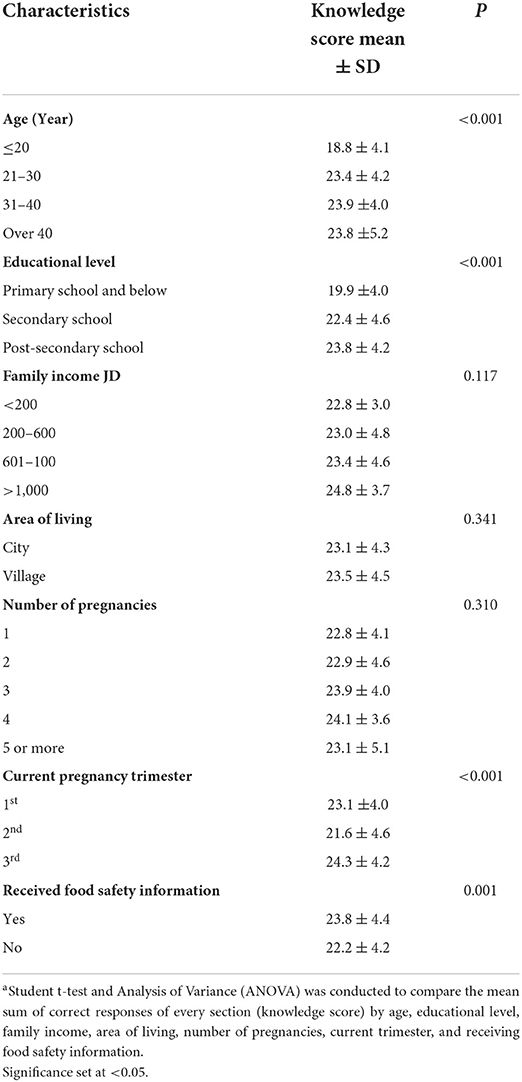
Table 9. Association between total food safety awareness score sociodemographic characteristics of participants (n = 325)a.
In the USA, women experiencing their first pregnancy had the lowest food safety scores while women who had multiple children were more knowledgeable and were more likely older (Trepka et al., 2007). No such significant association was recorded in the current study. Literature suggests that the susceptibility of pregnant women increases with the progression of pregnancy due to a reduction in cell-mediated immunity (Lamont et al., 2011). Pregnant women who were in their third trimester were most aware of food safety in the present study. Family income and area of living had no impact on food safety awareness in the current study.
Food safety and COVID-19
Attitude and practices
About three in four pregnant women in the present study expressed that the COVID-19 pandemic had increased their concerns regarding food safety as shown in Figure 3. Moreover, about two-thirds of them were concerned about getting infected by the COVID-19 virus from delivered food and from eating at restaurants (68.0 and 64.6%, respectively). These findings are expected as most of the participants believed that pregnant women are at higher risk of complications if they were to be infected with COVID-19. Moreover, since the beginning of the pandemic, official records emphasized the importance of maintaining personal hygiene and handling food according to proper food safety measures (FAO, 2020; FDA, 2021).
During the COVID-19 pandemic, the majority of the participants reported using cleaning and disinfecting agents more frequently and eating less from restaurants (88.3 and 80.9%, respectively) (Figure 4). Similar findings were reported among university students in Jordan as 78.0% of them reported dining out less frequently during the pandemic (Osaili et al., 2021). Maintaining proper personal hygiene, frequent cleaning, and disinfection of contaminated surfaces are all core actions that limit the transmission of the COVID-19 virus (FDA, 2021). However, despite the increased level of concern among participants, the level of practice was lower than expected. Less than half of them reported disinfecting food delivery packages before eating or storing and wiping food packages after shopping with disinfectant during the COVID-19 pandemic (44.9 and 46.5%, respectively). This was higher than observation made among consumers in Indonesia and Malaysia (40.0%) (Soon et al., 2021), but lower than that in the MENA region (65.0%) (Cheikh Ismail et al., 2021).
Logistic regression of reported enhanced food safety measures during the COVID-19 pandemic
Figure 5 shows the query statements and responses concerning enhanced food safety measures in the domains of cross-contamination, personal hygiene, temperature control, and cleaning and sanitation. Most participants agreed that the pandemic has had a positive impact on enhancing the measures taken to decrease food contamination, maintain personal hygiene at a high level, control the temperature of food during storage, cooking, and holding, and clean and sanitize food and food contact surfaces (74.5–85.8%). A recent meta-analysis of 48 studies on knowledge, attitude, and practice during the COVID-19 pandemic indicated that the overall scores of the three components were 78.9, 79.8, and 74.1%, respectively (Saadatjoo et al., 2021).
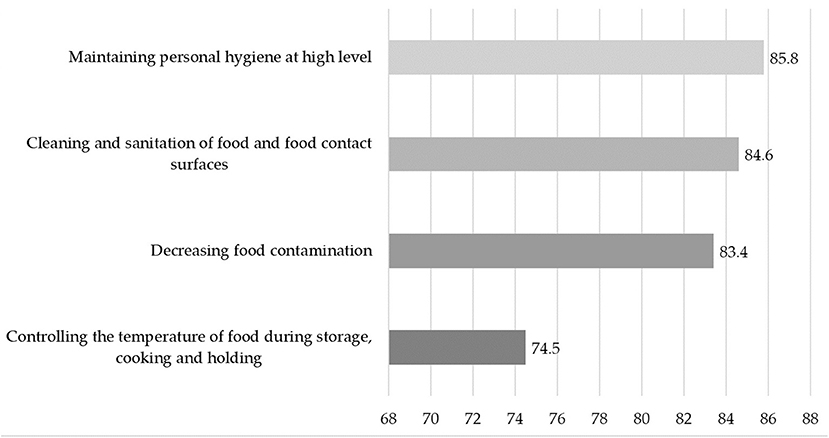
Figure 5. Participants answering “Yes” to “Did the COVID-19 pandemic enhance your food safety measures in the following aspects?” (n = 325).
Moreover, binary logistic regression was conducted to further investigate the relationship between those who reported enhanced food safety measures with their scores in the corresponding domain as shown in Table 10. Binary logistic regression revealed a positive relationship between the following enhanced food safety-related practices and their corresponding specific food safety domain score: decreasing food contamination; maintaining personal hygiene at a high level; as well as controlling the temperature of food during storage, cooking, and holding (p < 0.001, p < 0.001, and p = 0.005, respectively). These results indicated that people who reported enhanced food safety measures had better knowledge scores in the matching domain as opposed to people not reporting enhancing food safety measures. However, no significant association was observed for enhanced cleaning and sanitation of food and food contact surfaces. This could be explained as people might be adherent to good cleaning and sanitation practices as a general practice in their day-to-day life. Nonetheless, it is important to note that, while COVID-19 has increased the level of concern regarding food safety and enhanced the measures taken to maintain it, greater emphasis should be put on the fact that this group is at an increased risk of foodborne diseases in general and all their acquired practices should be maintained regardless of a pandemic.
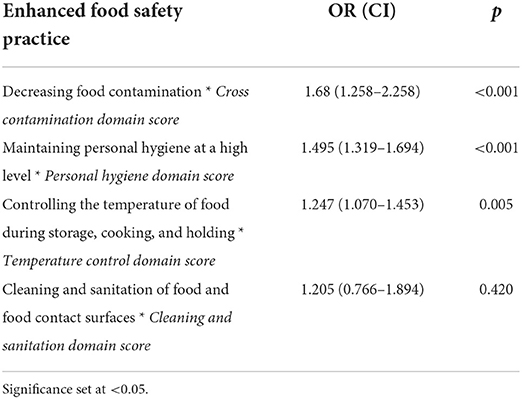
Table 10. Binary logistic regression of enhanced food safety measures during the COVID-19 pandemic of the study population and the aligned food safety domain score (n = 325).
Strengths and limitations
The tool used to collect data in the study was a questionnaire. As a questionnaire involves no observation and self-response, the data recorded could be prone to bias from the respondent. Although the study did not collect personal information, to look good, the respondents may have answered all questions correctly/positively (social desirability bias). Evidence suggests that reported food safety practices vs. observed food safety practices are usually not in tandem (Redmond and Griffith, 2003). Furthermore, using an online survey limited the reach of the survey to only those who have internet access. The population with no or poor internet access was left out. This could lead to less generalizability of the results. On the other hand, given the precautions taken due to the pandemic and the vulnerability of the studied group (pregnant women), this design allowed data collection from a larger number of participants with no associated risks of contact. Other strengths of this research include being the first study to assess food safety knowledge among pregnant women in Jordan. In addition, this study identified gaps in knowledge amongst this group, thereby opening scopes for improvement. This can be done by developing proactive and efficient interventional strategies which involve health care professionals, family doctors, public health professionals, nurses, and via pre-natal/pre-marital counseling.
Conclusion
Data from this study revealed that food safety-associated education for pregnant women needs a more robust reinforcement. This role can be taken up by health care providers and local health authorities. Pregnant women in Jordan have suboptimal food safety awareness levels, particularly in cross-contamination, safe food consumption, and temperature control domains. Knowing did not necessarily translate to having better food safety practices. Moreover, while the COVID-19 pandemic remains to be a threat, pregnant women must be well-educated about the nature of the virus, and its prevention strategies to avoid being infected. This includes providing pregnant women with educational sessions and preparing informative, easy-to-understand material regarding food safety principles and application at home with an emphasis on weaknesses described in our study. Nonetheless, education on food safety is recommended for all groups and should focus on the “five keys to safer food” guide by the WHO (Fontannaz-Aujoulat et al., 2019). Future studies should involve participants from other Jordanian/Middle East regions. The most appropriate method for a successful interventional program (e.g., via counseling/brochure distribution/ lecture format) and at which stage (pre-marital/pre-conceptual/first or second trimester/school or university) for this segment of the population can also be studied.
Data availability statement
The raw data supporting the conclusions of this article will be made available by the authors, without undue reservation.
Ethics statement
The studies involving human participants were reviewed and approved by Jordan University of Science and Technology (JUST) [Number: 100/136/2020]. The patients/participants provided their written informed consent to participate in this study.
Author contributions
TO, AA-N, AA, and LC conceptualized and designed the project. SA, NO, AS, LE, and HA prepared the original protocol. MM, SS, TO, AA-N, and LC did data management and analysis. SA, TO, AA-N, NO, AS, LE, HA, MM, SS, RA, AA, and LC collaborated in the overall implementation and data collection of the project and read the report and made suggestions on its content. SA, MM, and SS wrote the original report with input from all co-authors. All authors approved the final manuscript.
Acknowledgments
We acknowledge pregnant women who participated in this study and all those who helped in the data collection.
Conflict of interest
The authors declare that the research was conducted in the absence of any commercial or financial relationships that could be construed as a potential conflict of interest.
Publisher's note
All claims expressed in this article are solely those of the authors and do not necessarily represent those of their affiliated organizations, or those of the publisher, the editors and the reviewers. Any product that may be evaluated in this article, or claim that may be made by its manufacturer, is not guaranteed or endorsed by the publisher.
Supplementary material
The Supplementary Material for this article can be found online at: https://www.frontiersin.org/articles/10.3389/fsufs.2022.996302/full#supplementary-material
References
Alsayeqh, A. F. (2015). Foodborne disease risk factors among women in Riyadh, Saudi Arabia. Food Control 50, 85–91. doi: 10.1016/j.foodcont.2014.08.036
Athearn, P. N., Kendall, P. A., Hillers, V. V., Schroeder, M., Bergmann, V., Chen, G., et al. (2004). Awareness and acceptance of current food safety recommendations during pregnancy. Matern. Child Health J. 8, 149–162. doi: 10.1023/B:MACI.0000037648.86387.1d
Ayaz, W. O., Priyadarshini, A., and Jaiswal, A. K. (2018). Food safety knowledge and practices among Saudi mothers. Foods 7, 193. doi: 10.3390/foods7120193
Badrie, N., Gobin, A., Dookeran, S., and Duncan, R. (2006). Consumer awareness and perception to food safety hazards in Trinidad, West Indies. Food Control 17, 370–377. doi: 10.1016/j.foodcont.2005.01.003
Burton, M., Cobb, E., Donachie, P., Judah, G., Curtis, V., and Schmidt, W.-P. (2011). The effect of handwashing with water or soap on bacterial contamination of hands. Int. J. Environ. Res. Public Health 8, 97–104. doi: 10.3390/ijerph8010097
Cater, M., Gravois, R., Guerra Gaitan, G. G., and Xu, W. (2020). Pregnant women's confidence and perceptions on practices related to food safety: a study in Louisiana. Food Control 113, 107175. doi: 10.1016/j.foodcont.2020.107175
Cheikh Ismail, L., Osaili, T. M., Mohamad, M. N., Al Marzouqi, A., Jarrar, A. H., Zampelas, A., et al. (2021). Assessment of eating habits and lifestyle during the coronavirus 2019 pandemic in the Middle East and North Africa region: a cross-sectional study. Br. J. Nutr. 126, 757–766. doi: 10.1017/S0007114520004547
Chenarides, L., Grebitus, C., Lusk, J. L., and Printezis, I. (2021). Food consumption behavior during the COVID-19 pandemic. Agribusiness 37, 44–81. doi: 10.1002/agr.21679
de Jong, A. E. I., Verhoeff-Bakkenes, L., Nauta, M. J., and de Jonge, R. (2008). Cross-contamination in the kitchen: effect of hygiene measures. J. Appl. Microbiol. 105, 615–624. doi: 10.1111/j.1365-2672.2008.03778.x
Duda-Chodak, A., Lukasiewicz, M., Zieć, G., Florkiewicz, A., and Filipiak-Florkiewicz, A. (2020). COVID-19 pandemic and food: present knowledge, risks, consumers fears and safety. Trends Food Sci. Technol. 105, 145–160. doi: 10.1016/j.tifs.2020.08.020
Fawzi, M., and Shama, M. E. (2009). Food safety knowledge and practices among women working in Alexandria University, Egypt. J. Egypt. Public Health Assoc. 84, 95–117.
FDA (2021). Food Safety and the Coronavirus Disease 2019 (COVID-19) Available online at: https://www.fda.gov/food/food-safety-during-emergencies/food-safety-and-coronavirus-disease-2019-covid-19 (accessed December 20, 2021).
Fontannaz-Aujoulat, F., Frost, M., and Schlundt, J. (2019). WHO Five Keys to Safer Food communication campaign - Evidence-based simple messages with a global impact. Food Control 101, 53–57. doi: 10.1016/j.foodcont.2019.02.016
Gallè, F., Sabella, E. A., Da Molin, G., De Giglio, O., Caggiano, G., Di Onofrio, V., et al. (2020). Understanding knowledge and behaviors related to COVID−19 epidemic in Italian undergraduate students: the EPICO study. Int. J. Environ. Res. Public Health 17, 3481. doi: 10.3390/ijerph17103481
Guneri, S., Sen, S., Satir, D., Ozturk, R., Cetisli, N., and Sirin, A. (2017). Knowledge, attitudes and behaviors of pregnant women about food safety: a cross sectional survey. Int. J. Caring Sci. 10, 705.
Haddad, F., Yahfoufi, N., Abou Haidar, M., and Hoteit, M. (2020). Knowledge, attitude and practices of Lebanese married women towards food safety. Atena J. Public Health 6, 1. Available online at: https://atenajournals.com/ajph/article/view/7
Han, S., Roy, P. K., Hossain, M. I., Byun, K.-H., Choi, C., and Ha, S.-D. (2021). COVID-19 pandemic crisis and food safety: implications and inactivation strategies. Trends Food Sci. Technol. 109, 25–36. doi: 10.1016/j.tifs.2021.01.004
Haque, M. (2020). Handwashing in averting infectious diseases: relevance to COVID-19. J. Popul. Ther. Clin. Pharmacol. 27, e37–e52. doi: 10.15586/jptcp.v27SP1.711
Haysom, I. W., and Sharp, A. K. (2005). Bacterial contamination of domestic kitchens over a 24-hour period. Br. Food J. 107, 453–466. doi: 10.1108/00070700510606873
Hillers, V. N., Medeiros, L., Kendall, P., Chen, G., and DiMascola, S. (2003). Consumer food-handling behaviors associated with prevention of 13 foodborne illnesses. J. Food Prot. 66, 1893–1899. doi: 10.4315/0362-028X-66.10.1893
Jay, L. S., Comar, D., and Govenlock, L. D. (1999). A video study of Australian domestic food-handling practices. J. Food Prot. 62, 1285–1296. doi: 10.4315/0362-028X-62.11.1285
Jevšnik, M., Hoyer, S., and Raspor, P. (2008). Food safety knowledge and practices among pregnant and non-pregnant women in Slovenia. Food Control 19, 526–534. doi: 10.1016/j.foodcont.2007.06.005
Josephson, K. L., Rubino, J. R., and Pepper, I. L. (1997). Characterization and quantification of bacterial pathogens and indicator organisms in household kitchens with and without the use of a disinfectant cleaner. J. Appl. Microbiol. 83, 737–750. doi: 10.1046/j.1365-2672.1997.00308.x
Kaiser, L. L., and Allen, L. (2002). Position of the American Dietetic Association: nutrition and lifestyle for a healthy pregnancy outcome. J. Am. Diet. Assoc. 102, 1479–1490. doi: 10.1016/S0002-8223(02)90327-5
Kotlyar, A. M., Grechukhina, O., Chen, A., Popkhadze, S., Grimshaw, A., Tal, O., et al. (2021). Vertical transmission of coronavirus disease 2019: a systematic review and meta-analysis. Am. J. Obstet. Gynecol. 224, 35–53.e33. doi: 10.1016/j.ajog.2020.07.049
Lamont, R. F., Sobel, J., Mazaki-Tovi, S., Kusanovic, J. P., Vaisbuch, E., Kim, S. K., et al. (2011). Listeriosis in human pregnancy: a systematic review. J. Perinat. Med. 39, 227–236. doi: 10.1515/jpm.2011.035
Langiano, E., Ferrara, M., Lanni, L., Viscardi, V., Abbatecola, A. M., and De Vito, E. (2012). Food safety at home: knowledge and practices of consumers. Z. Gesundh. Wiss. 20, 47–57. doi: 10.1007/s10389-011-0437-z
Lazou, T., Georgiadis, M., Pentieva, K., McKevitt, A., and Iossifidou, E. (2012). Food safety knowledge and food-handling practices of Greek university students: a questionnaire-based survey. Food Control 28, 400–411. doi: 10.1016/j.foodcont.2012.05.027
Li-Cohen, A. E., and Bruhn, C. M. (2002). Safety of consumer handling of fresh produce from the time of purchase to the plate: a comprehensive consumer survey. J. Food Prot. 65, 1287–1296. doi: 10.4315/0362-028X-65.8.1287
Lyon, B. G., Berry, B. W., Soderberg, D., and Clinch, N. (2000). Visual color and doneness indicators and the incidence of premature brown color in beef patties cooked to four end point temperatures. J. Food Prot. 63, 1389–1398. doi: 10.4315/0362-028X-63.10.1389
Mahon, D., Cowan, C., Henchion, M., and Fanning, M. (2006). Food-handling practices of Irish beef consumers. J. Food Saf. 26, 72–81. doi: 10.1111/j.1745-4565.2005.00028.x
Medeiros, L. C., Kendall, P., Hillers, V., Chen, G., and DiMascola, S. (2001). Identification and classification of consumer food-handling behaviors for food safety education. J. Am. Diet. Assoc. 101, 1326–1339. doi: 10.1016/S0002-8223(01)00318-2
Min, S., Xiang, C., and Zhang, X.-H. (2020). Impacts of the COVID-19 pandemic on consumers' food safety knowledge and behavior in China. J. Integr. Agric. 19, 2926–2936. doi: 10.1016/S2095-3119(20)63388-3
Osaili, T., Al-Nabulsi, A., and Taybeh, A. (2021). Food safety knowledge, attitudes, and practices among Jordan universities students during the COVID-19 pandemic. Front Public Health 9, 729816. doi: 10.3389/fpubh.2021.729816
Osaili, T., Obaid, R., Alowais, K., Almahmood, R., Almansoori, M., Alayadhi, N., et al. (2020). Microbiological quality of kitchens sponges used in university student dormitories. BMC Public Health 20, 1322. doi: 10.1186/s12889-020-09452-4
Osaili, T., Obeidat, B., Abu Jamous, D., and Bawadi, H. (2011). Food safety knowledge and practices among college female students in north of Jordan. Food Control 22, 269–276. doi: 10.1016/j.foodcont.2010.07.009
Osaili, T., Saeed, B. Q., Taha, S., Omar Adrees, A., and Hasan, F. (2022). Knowledge, practices, and risk perception associated with foodborne illnesses among females living in Dubai, United Arab Emirates. Foods 11, 290. doi: 10.3390/foods11030290
Pereboom, M. T. R., Manniën, J., Spelten, E. R., Schellevis, F. G., and Hutton, E. K. (2013). Observational study to assess pregnant women's knowledge and behaviour to prevent toxoplasmosis, listeriosis and cytomegalovirus. BMC Pregnancy Childbirth 13, 98. doi: 10.1186/1471-2393-13-98
Ramsey, P. S., and Ramin, K. D. (2001). Pneumonia in pregnancy. Obstet. Gynecol. Clin. North Am. 28, 553–569. doi: 10.1016/S0889-8545(05)70217-5
Redmond, E. C., and Griffith, C. J. (2003). Consumer food handling in the home: a review of food safety studies. J. Food Prot. 66, 130–161. doi: 10.4315/0362-028X-66.1.130
Redmond, E. C., and Griffith, C. J. (2004). Consumer perceptions of food safety risk, control and responsibility. Appetite 43, 309–313. doi: 10.1016/j.appet.2004.05.003
Saadatjoo, S., Miri, M., Hassanipour, S., Ameri, H., and Arab-Zozani, M. (2021). Knowledge, attitudes, and practices of the general population about Coronavirus disease 2019 (COVID-19): a systematic review and meta-analysis with policy recommendations. Public Health 194, 185–195. doi: 10.1016/j.puhe.2021.03.005
Saeed, B. Q., Osaili, T. M., and Taha, S. (2021). Foodborne diseases risk factors associated with food safety knowledge and practices of women in Sharjah-United Arab Emirate. Food Control 125, 108024. doi: 10.1016/j.foodcont.2021.108024
Soon, J. M., Vanany, I., Abdul Wahab, I. R., Hamdan, R. H., and Jamaludin, M. H. (2021). Food safety and evaluation of intention to practice safe eating out measures during COVID-19: cross sectional study in Indonesia and Malaysia. Food Control 125, 107920. doi: 10.1016/j.foodcont.2021.107920
Tam, C., Erebara, A., and Einarson, A. (2010). Food-borne illnesses during pregnancy: prevention and treatment. Can. Fam. Physician 56, 341–343.
Taylor, M., Kelly, M., Noël, M., Brisdon, S., Berkowitz, J., Gustafson, L., et al. (2012). Pregnant women's knowledge, practices, and needs related to food safety and listeriosis: a study in British Columbia. Can. Fam. Physician 58, 1106–1112.
Trepka, M. J., Murunga, V., Cherry, S., Huffman, F. G., and Dixon, Z. (2006). Food safety beliefs and barriers to safe food handling among WIC program clients, Miami, Florida. J. Nutr. Educ. Behav. 38, 371–377. doi: 10.1016/j.jneb.2006.05.022
Trepka, M. J., Newman, F. L., Dixon, Z., and Huffman, F. G. (2007). Food safety practices among pregnant women and mothers in the women, infants, and children program, Miami, Florida. J. Food Prot. 70, 1230–1237. doi: 10.4315/0362-028X-70.5.1230
WHO (2020a). Coronavirus Disease (COVID-19): Food Safety and Nutrition. Available online at: https://www.who.int/news-room/questions-and-answers/item/coronavirus-disease-covid-19-food-safety-and-nutrition (accessed December 20, 2021).
WHO (2020b). Coronavirus Disease (COVID-19): Pregnancy and Childbirth. Available online at: https://www.who.int/news-room/q-a-detail/coronavirus-disease-covid-19-pregnancy-and-childbirth (accessed December 21, 2021).
WHO (2020c). COVID-19 High Risk Groups. Available online at: https://www.who.int/westernpacific/emergencies/covid-19/information/high-risk-groups (accessed December 21, 2021).
WHO (2020e). Food Safety-Key Facts. Available online at: https://www.who.int/news-room/fact-sheets/detail/food-safety (accessed December 16, 2021).
Wu, J. T., Leung, K., and Leung, G. M. (2020). Nowcasting and forecasting the potential domestic and international spread of the 2019-nCoV outbreak originating in Wuhan, China: a modelling study. Lancet 395, 689–697. doi: 10.1016/S0140-6736(20)30260-9
Wu, Y. N., Liu, X. M., Chen, Q., Liu, H., Dai, Y., Zhou, Y.-J., et al. (2018). Surveillance for foodborne disease outbreaks in China, 2003 to 2008. Food Control 84, 382–388. doi: 10.1016/j.foodcont.2017.08.010
Xu, W., Cater, M., Gaitan, A., Drewery, M., Gravois, R., and Lammi-Keefe, C. J. (2017). Awareness of Listeria and high-risk food consumption behavior among pregnant women in Louisiana. Food Control 76, 62–65. doi: 10.1016/j.foodcont.2017.01.009
Keywords: COVID-19, food safety, pregnant women, foodborne disease, knowledge
Citation: Almanasrah S, Osaili TM, Al-Nabulsi AA, Obeidat NA, Sindiani AM, Elsalem L, Alkhalidy H, Mohamad MN, Saleh ST, Al Daour R, Al Dhaheri AS and Cheikh Ismail L (2022) Food safety knowledge and risk perception among pregnant women: A cross-sectional study in Jordan during the COVID-19 pandemic. Front. Sustain. Food Syst. 6:996302. doi: 10.3389/fsufs.2022.996302
Received: 17 July 2022; Accepted: 11 August 2022;
Published: 31 August 2022.
Edited by:
Delia Grace, University of Greenwich, United KingdomReviewed by:
Seydi Yikmiş, Namik Kemal University, TurkeyTabussam Tufail, University of Lahore, Pakistan
Copyright © 2022 Almanasrah, Osaili, Al-Nabulsi, Obeidat, Sindiani, Elsalem, Alkhalidy, Mohamad, Saleh, Al Daour, Al Dhaheri and Cheikh Ismail. This is an open-access article distributed under the terms of the Creative Commons Attribution License (CC BY). The use, distribution or reproduction in other forums is permitted, provided the original author(s) and the copyright owner(s) are credited and that the original publication in this journal is cited, in accordance with accepted academic practice. No use, distribution or reproduction is permitted which does not comply with these terms.
*Correspondence: Tareq M. Osaili, dG9zYWlsaUBqdXN0LmVkdS5qbw==; dG9zYWlsaUBzaGFyamFoLmFjLmFl
†These authors have contributed equally to this work and share first authorship
 Safaa Almanasrah1†
Safaa Almanasrah1† Tareq M. Osaili
Tareq M. Osaili Anas A. Al-Nabulsi
Anas A. Al-Nabulsi Hana Alkhalidy
Hana Alkhalidy Maysm N. Mohamad
Maysm N. Mohamad Sheima T. Saleh
Sheima T. Saleh Rameez Al Daour
Rameez Al Daour Ayesha S. Al Dhaheri
Ayesha S. Al Dhaheri Leila Cheikh Ismail
Leila Cheikh Ismail